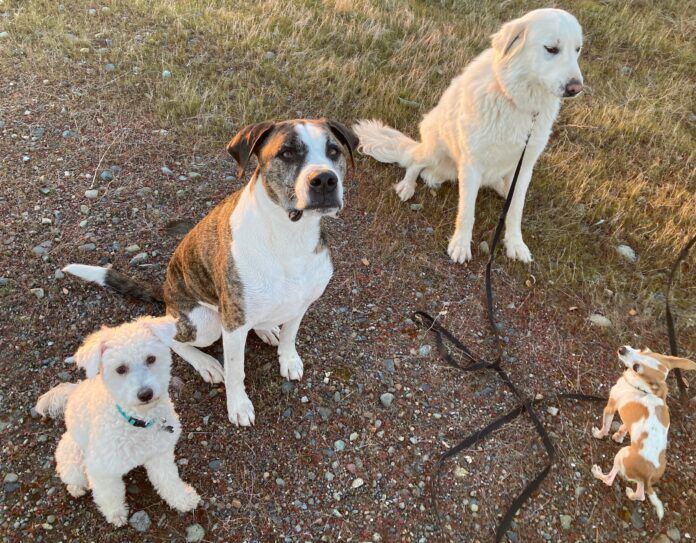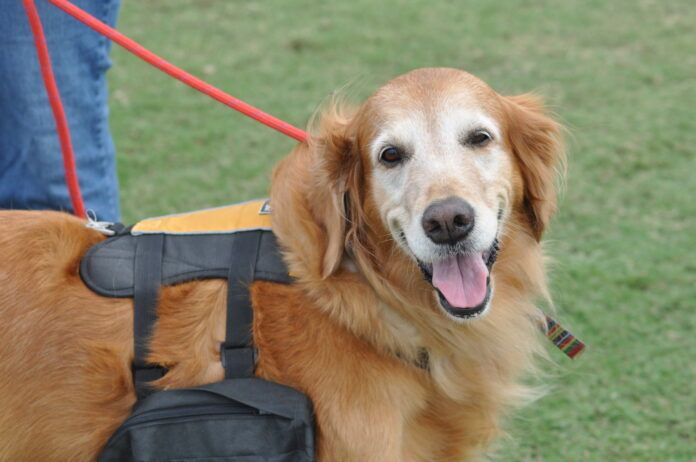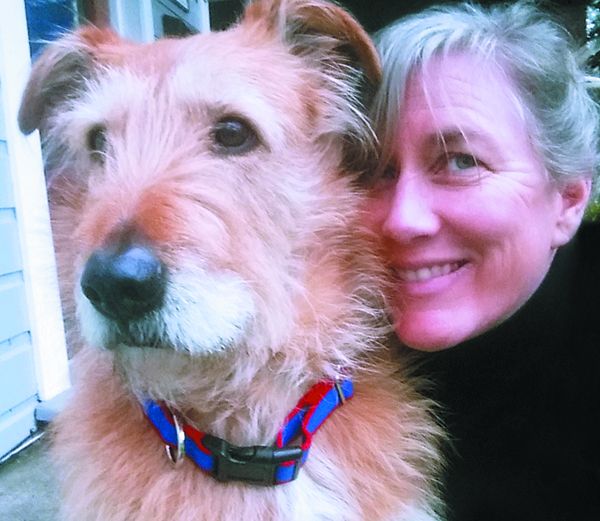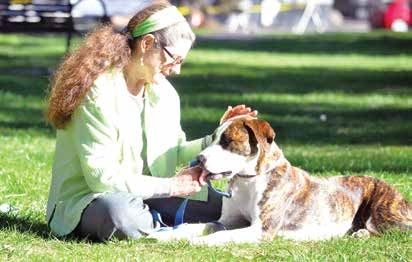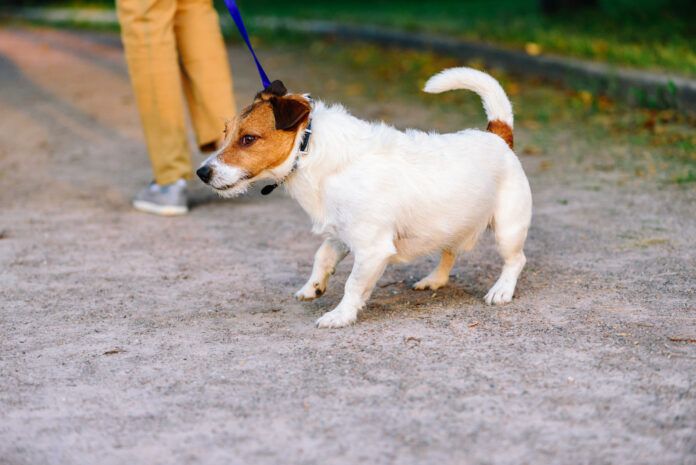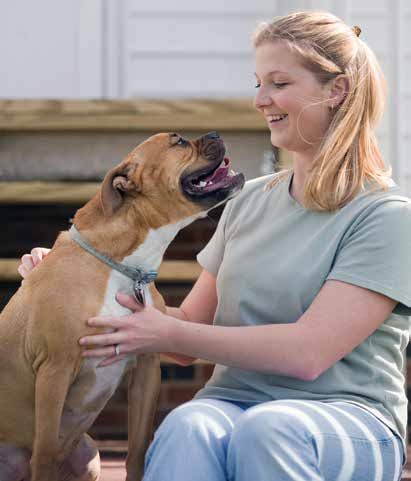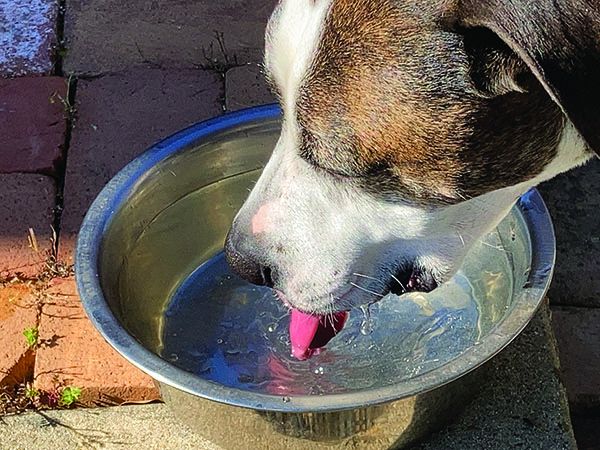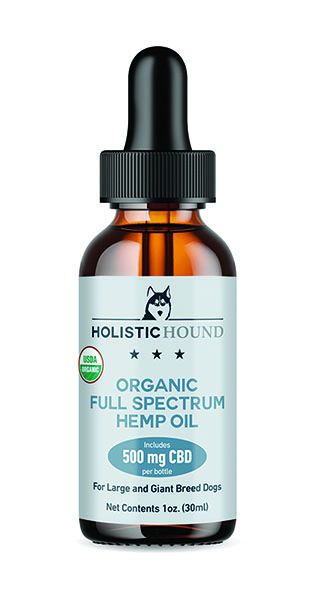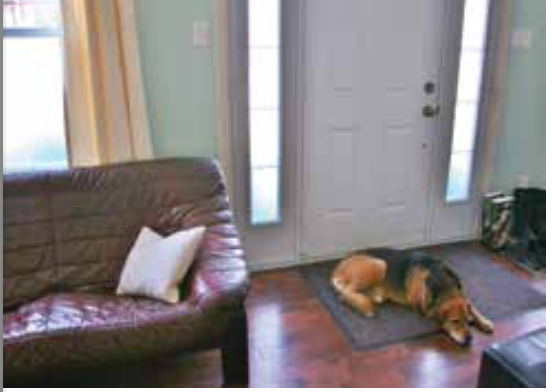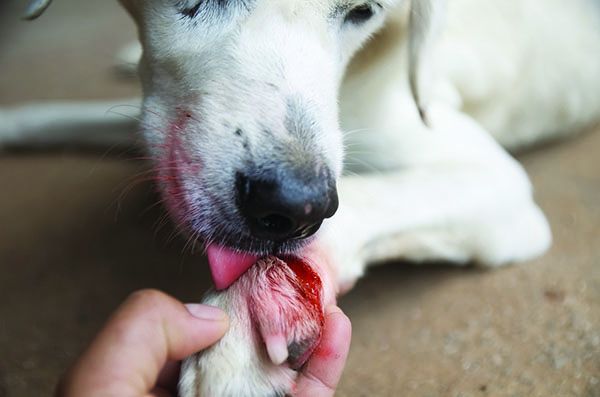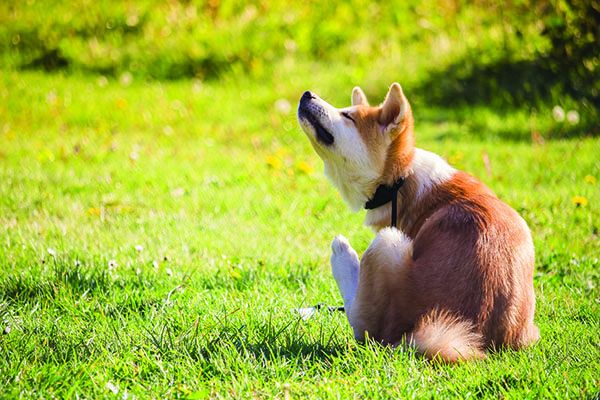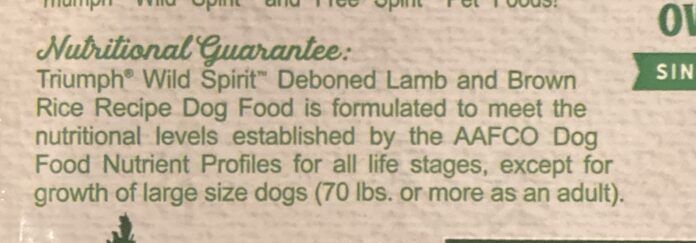I’ve been doing a lot of fostering and co-fostering and rescuing lately, and I’ve written about it here and on the WDJ Instagram page, and a bunch of the dogs have been placed now, so I’m going to update all their stories here:
In mid-January, my friend Leonora and I went to our local shelter to look at a few older puppies that were there – and we ended up bringing home a super shut-down Great Pyrenees who had come into the shelter as a stray and had been adopted and returned twice. We felt so sorry for her; she was just terrified at being back at the shelter. Leonora has a large section of her property fenced with a six-foot chain link fence, so we brought the dog to her house to hang out for the Dr. Martin Luther King, Jr., three-day weekend – and this dog has turned into a larger project than either of us imagined she might.

Leonora has a tiny dog named Samson, so we started calling the Pyrenees Delilah, just for fun. Delilah started out afraid of everything – we had to push and pull her through doorways to get her into and then out of the house, and she slept in Leonora’s bathroom at first. Sometimes she would run right to us for affection and petting – and other times, especially if she sensed you wanted to put her on a leash (whether to take a walk or get in the car), she would run away and refuse to come even for the nicest treats, pacing just out of our reach. Once she learned Leonora’s schedule, and anticipating being locked up either in the house or the very large outdoor yard (with shelter) so Leonora could go to work, she started running away (within the fenced acre) as soon as she would be taken outside to go potty. Leonora had to leash her on work mornings so she couldn’t delay Leonora’s departure. This annoying habit aside, she very slowly started to reveal more and more of her anxious but sweet disposition, and so Leonora kept her on for some weeks, allowing her to decompress from her past and apparently traumatic experiences.
At the same time, I was fostering a Maltese/Poodle-mix that a friend had adopted and then had second thoughts about. Sophie had been adopted from a home where she was neglected and insufficiently trained or supervised; she had lots of unpleasant behaviors when I first brought her home. She would get distracted and tense outdoors and not go potty, waiting until I brought her back in the house; then she would sneak off into a back bedroom and go. (Obviously, once I realized that was her pattern, I made sure to wait outside with her until she “went,” and only then would bring her back in.) She was prone to screaming when put in a crate, and had some separation anxiety. She would also bark and scream in the car, and let out a piercing BARK when anything startled her (which would startle a statue, I swear). I committed to keeping her for a month of training and then started looking for a good home for her.
I started her behavior-modification plan with TONS of exercise. We went for off-leash walks daily and played fetch several times daily, for a total of at least an hour a day. With her exercise needs finally met, her behavior improved by the day.
In early February, Leonora and I were taking our dogs (my old Otto and middle-aged Woody, and her middle-aged tiny Samson, plus our fosters Delilah and Sophie) for an off-leash (except for Delilah) walk in our local wildlife area near the Feather River, when we found a young dog who had been apparently dumped (or perhaps just lost) out there. He was adorable, and desperate to come with us, so we loaded him (somehow) into Leonora’s car and took him to our local shelter. I returned the next day and put up fliers in that area, and I checked the shelter website weekly, hoping someone would come to claim him, but no luck. The shelter named him River and he spent weeks and weeks on the adoption row.

The challenge of re-homing Sophie was that she looked like a gorgeous little lap dog for an older person – but behaved like a field-bred Labrador who wanted nothing more than to run for hours every day, preferably chasing a ball. I knew that if she were rehomed with someone who didn’t give her enough exercise, all of her not-very-enjoyable traits would come back.
I started promoting her through my personal Facebook page, with no takers. Another friend who has a nonprofit rescue offered to promote her through her group’s Petfinder account – and almost immediately we were inundated with emails and calls from older people. We had stated in the post that this was an active, barky dog who needed miles and miles of exercise daily, so almost every inquiry started, “I’m an active older person…” The problem was, all of these people went on to say they walk a mile a day, or they could walk her three miles a day and throw a ball in their backyard – and since I was walking her about 4 miles off leash every day (where she probably walked 6 miles) and throwing the ball all the way across my two acres with a Chuckit for about an hour day, none of those options sounded like enough. I didn’t want to set up Sophie for failure again, so I stuck to my guns (even though it was really hard, people were so nice!). But I felt strongly we needed someone younger and more active.
In mid-February, I was at the shelter, training a new volunteer, when some people came in with a big plastic Rubbermaid storage tub. We dread seeing tubs like this; they are always full of puppies and this was no exception. ELEVEN puppies, to be exact. Of course, the people said they “found” the puppies, who looked to be about five weeks old. The shelter staffers and I were dubious about this – I pick up strays all the time but have never found a litter of puppies! – but the shelter would rather have people bring unwanted puppies into the shelter than abandon them or sell them, unfixed. But given that we already had three litters of puppies at the shelter, and since I already had a foster dog keeping me mostly at home, I said I could foster the litter until they were old enough to get adopted. The staff took the pups into the treatment room to deworm them and get “weights, temps, and pics” of each pup. I kept working with the volunteer.

About an hour later, someone else brought another, older puppy into the shelter, saying they found him sitting in the middle of a street. A staffer came to find me, where I was still working with the volunteer. “Look,” she said, “It’s a baby Otto!” And indeed, the scruffy-faced youngster, perhaps about 8 weeks old, did look like Otto. “Could you take him home, too? What’s the difference between 11 and 12 puppies?” she asked. I said, “Sure, ok, but I better get out of here before any more puppies get brought in!”
Thank goodness for a mild spring. I was able to set up all the puppies in a large covered pen outdoors, with a special heating pad for dogs at the bottom of the dog house for cooler nighttime temperatures. I put down a thick layer of wood shavings on the bottom of the pen, and let them out to eat morning to eat from the puppy “donut” pans while I pick up all the poop in the pen. Every few days I remove all the shavings and hose the pen and let it dry completely before bedding it again.

My son was born in early March, and he turned 30 this year – astonishing because he was just five when I was hired to edit the inaugural issue of Whole Dog Journal. His fiancée threw him a surprise party, and I hired a young person I know, who used to rent a room from me at my office/house, to look after the puppies for a night so my husband and I could go to the Bay Area and attend the surprise party and see some friends. The adult dogs got split between my sister’s house and Leonora’s house. My husband had fun telling everyone, “Well, we have to get home. You know Nancy has 15 dogs at home, don’t you?” Shoot, he was right: Otto and Woody, the Maltipoo, and 12 puppies. Oy!

In mid-March, I received an application for the Maltipoo from a couple who lived about four hours from me. They appeared to be in their late 40s, no kids. They worked at home. They lived on acreage. They walk a lot – and had owned hunting dogs in the past, as well as little dogs in the very recent past. To make a long story short, I ended up driving to their house and meeting them and their other little dog, and was satisfied that they were home enough, committed enough, active enough, and knowledgeable enough to take on Sophie and all her crazy behaviors. They loved her at first sight and I left her with them that day. They love and appreciate her sweetness and activity level and interest in playing and learning tricks. It was a perfect adoption, and I’m grateful to my friend for sharing her post.
Then another friend who runs a small rescue group contacted me about the litter of 11, offering to take some of them for her group to adopt. I contacted the shelter and asked if they’d like to transfer some of the pups to this other group. This would make things much easier when it came time to adopt them all; we wouldn’t have such a glut of very similar-looking puppies. My friend’s group took four of the pups – and I couldn’t believe how much easier it was to feed and clean up after eight puppies than 12 of them.

I started keeping the unrelated, older puppy with me and my adult dogs for much of the day. The age difference between him and the smaller, younger pups meant that they were starting to whine and run from him when he bounded toward them. I let him work that out with fun Uncle Woody, who was happy to roll the chunky pup over and let him blow off some steam by chewing more-or-less gently on each other’s limbs.
By this time, my friend Leonora had been fostering Delilah for two months. The beautiful dog was completely out of her shell now, racing in and out of the house with ease. She had finally become comfortable with every room in the house, would enter the living room and sleep on the couch, get in and out of the car with ease, and was getting a little better at meeting new people without running or freezing. We started promoting her on the shelter’s social media, emphasizing that she needed a soft landing due to her past failed placements.

The shelter took a call from one person who sounded great, who had a very securely fenced property of more than five acres; if she could live with horses, goats, chickens, barn cats, and other dogs, she could live there! Leonora and I drove her for an interview, to see how she would do, and it appeared as if she would be happy to live peacefully with all of those other species. We warned the adopter that with yet another change of home, she might be anxious again for a while. We begged her to give the big dog some time to adjust, but the adopter struggled with Delilah’s unpredictable, on-and-off habit of being hard to catch and difficult to convince to, alternately, come into the house or go out of the house. After not quite two weeks, she pulled the plug and returned the dog. This time, she came back to my house to stay here for a while.
But by now, the puppies were old enough and big enough for spay/neuter and adoption. The shelter had me send three puppies a week to the shelter, starting with the biggest ones, and they got snapped up as quickly as they got altered, with the last ones (except for the scruffy guy) going to their new families this week.

And get this! I went by the shelter on Monday evening, the one day they are open late, to bring in the last pup who was going to get neutered – just in time to see a young couple walking out the door with a dog they just adopted: It was River, the stray Leonora and I rescued from where he had been (presumably) dumped out in the wildlife area! A happy ending for that guy, too.
So what about the scruffy guy, who has been big enough and old enough, really, to go back to the shelter for adoption ever since his “stray dog hold” expired, a week into his stay with me? He’s got a predictable hold on my heart – predictable because dang, he looks so much like a baby Otto. I sent out his DNA to Wisdom Panel, and he even has some similarities in his VERY mixed mix.
Otto’s Mix (according to Wisdom Panel)
12.5% American Staffordshire Terrier
12.5% Australian Cattle Dog
12.5% Border Collie
12.5% Chow Chow
12.5 German Shepherd Dog
37.5% Breed Groups: Asian Terrier, Sporting, Guard
Scruffy’s Mix (according to Wisdom Panel)
36% American Staffordshire Terrier
29% American Pit Bull Terrier
6% Boxer
6% German Wirehaired Pointer
5% American Bulldog
4% Great Dane
3% Australian Cattle Dog
2% Chow Chow
I’ve been wrestling all this time with the decision: To adopt, or not to adopt? If Otto had already passed on, there would be no question; I’d love to keep him. He’s an extraordinarily calm, even-tempered pup, smart and confident without being at all cocky. He’s affectionate and playful – everything I’d want in a puppy!

But as Otto slows down and the puppy grows, there have been more moments where the puppy has annoyed Otto, or made him have to stop or turn suddenly. Otto hasn’t particularly enjoyed puppies since he was a very young dog, and in the past few years, he’s been openly impatient and intolerant of them. When they get within 10 feet of him, he starts growling; within four feet and he starts snarling and grrrrRUFFing at them. It’s been easy to keep the little puppies mostly away from him; they’ve come into close contact only outside, where there are plenty of more fun things for them to do and plenty of places where he can escape them. But obviously, if I keep the scruffy guy, the pup will be integrated into the household, where Otto can’t help but cross paths with him many times a day. I don’t want to see Otto unhappy.
I can’t say I’ve made a decision yet, but I’m starting to promote the scruffy pup to people I know, and asking them to promote him to dog-savvy people they know. In the meantime, he and Delilah have been spending nights together in my office; during the day, my office door is open and all the dogs – just four now! – can roam my two acres or snooze in my office with me while I work. We’ll see what the next few weeks bring.


